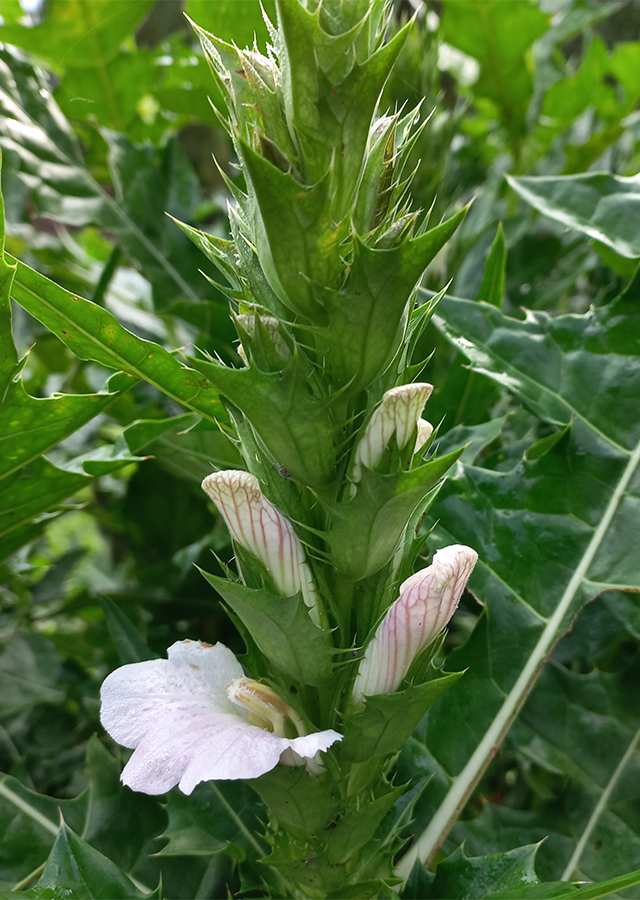Mountain Thistle
Acanthus montanus (Nees) T.Anderson
Acanthaceae
Location in our garden
Aquatic



Synonym
Acanthus barteri T. Anderson
Cheilopsis montana Nees
Habitus
Shrubs. Herbaceous perennial shrub that grows up to 2 m tall.
Part Used
Leaves
Roots
Growing Requirements
Full Sunshine
Habitat
Coastal
Grassland
Overview
Acanthus montanus is native to tropical western Africa. It is a sprawling forest understory plant that is grown as much for its attractive foliage as for its architecturally bold flower spikes and showy ornamental leaves. In Africa, it is considered an underutilized vegetable, and a famine food.This plant is called as alligator plant as the leaves shaped resemble to alligator. This shrub is widespread in Africa, the Balkans, Romania, Greece and Eastern Mediterranean.
Vernacular Names
Gebirgs-akanthus (German), Agamobo (Nigerian).
Agroecology
Grows in fertile, medium moisture, well-drained soils in full sun to part shade. Plants tolerate a wide range of soils except poorly-drained ones. Plants may not flower well in too much shade. Remove flowering stalks after bloom. Plants are evergreen in warm winter locations, but leaves will show considerable damage in colder winters near the northern edge of the growing range. Plants can spread invasively by creeping rootstocks, particularly in loose soils.
Morphology
- Stem - erect, many branced.
- Leaves - shallow to deeply lobed, toothed with short spines, dark glossy green above and pale green below, ovate to lanceolate, 30 cm long with acuminate tips and silvering are both showy and ornamental.
- Flowers - two-lipped, snapdragon-like, pink to rose flowers bloom in summer on upright flower spikes (to 25 cm long) which rise from the branch ends.
Cultivation
Vegetatively propagated from root cuttings taken in early spring, but may be grown from seed (generatively). Plants can be slow to establish in the garden (particularly if started from seed), but become somewhat difficult to eradicate once established since small sections of root left behind can sprout new plants.
Chemical Constituents
Alkaloids, flavonoids, glycosides, steroids, saponins, tannins, terpenoids, and many compounds from the aerial parts extract such as β- sitosterol-3-O-β –D-glucoside, palmitic acid, linaroside, homoplantagenin, 5, 7, 3′- trihydroxy-6,4′ -dimethoxy flavone-7-O-glucoside, shikimic acid, protochatecuic acid, blepharin, and acetoside.
Traditional Medicinal Uses
- Studies have suggested antimicrobial, antidiabetic, anti-inflammatory, analgesic, immunomodulatory, hepatoprotective, antifertility, fetotoxic, relaxant, anthelmintic, and mosquitocidal properties.
- In Nigeria, roots are used for furuncles, leaves used for boils on the fingers and for coughs. The plant is also used for the treatment of gonorrhea, syphilis, wounds, boils, hypertension, cardiac dysfunctions, and hepatitis.
- In the Congo, central portion of twigs or leaves applied as hot poultice to mature abscesses; decoction of leaf and twigs used as purgative.
- In Cameroon, used for treatment of epilepsy, fever, pain, inflammation and threatened abortion; leaf infusion used for cough and chest complaints.
- In Gabon, leaf-macerate is used in children as emetic; fresh young growths used for heart troubles.
Part Used
Reference Sources
- Igwe, Andrew, and Eleazu, Chinedum. (2017). Effect of processing on the biochemical contents of Acanthus montanus (Nees) T. Anderson (Acanthaceae) leaves. Food Science and Nutrition; 6(2): 388–394. doi: 10.1002/fsn3.567.
- Kew Royal Botanic Gardens (No date). Plants of The World nline: Acanthus montanus (Nees) T.Anderson. https://powo.science.kew.org/taxon/urn:lsid:ipni.org:names:44894-1. 05-03-2022.
- Missouri Botanical Garden. (No date). Acanthus montanus. https://www.missouribotanicalgarden.org/PlantFinder/PlantFinderDetails.aspx?taxonid=275329. 05-03-2022.
- Okoli, Charles A., et al. (2008). Acanthus montanus: an experimental evaluation of the antimicrobial, anti-inflammatory and immunological properties of a traditional remedy for furuncles. National Library of Medicine. doi: 10.1186/1472-6882-8-27.
- Stuartxchange. (2018). Mountain thistle. http://www.stuartxchange.org/MountainThistle. 05-03-2022.

